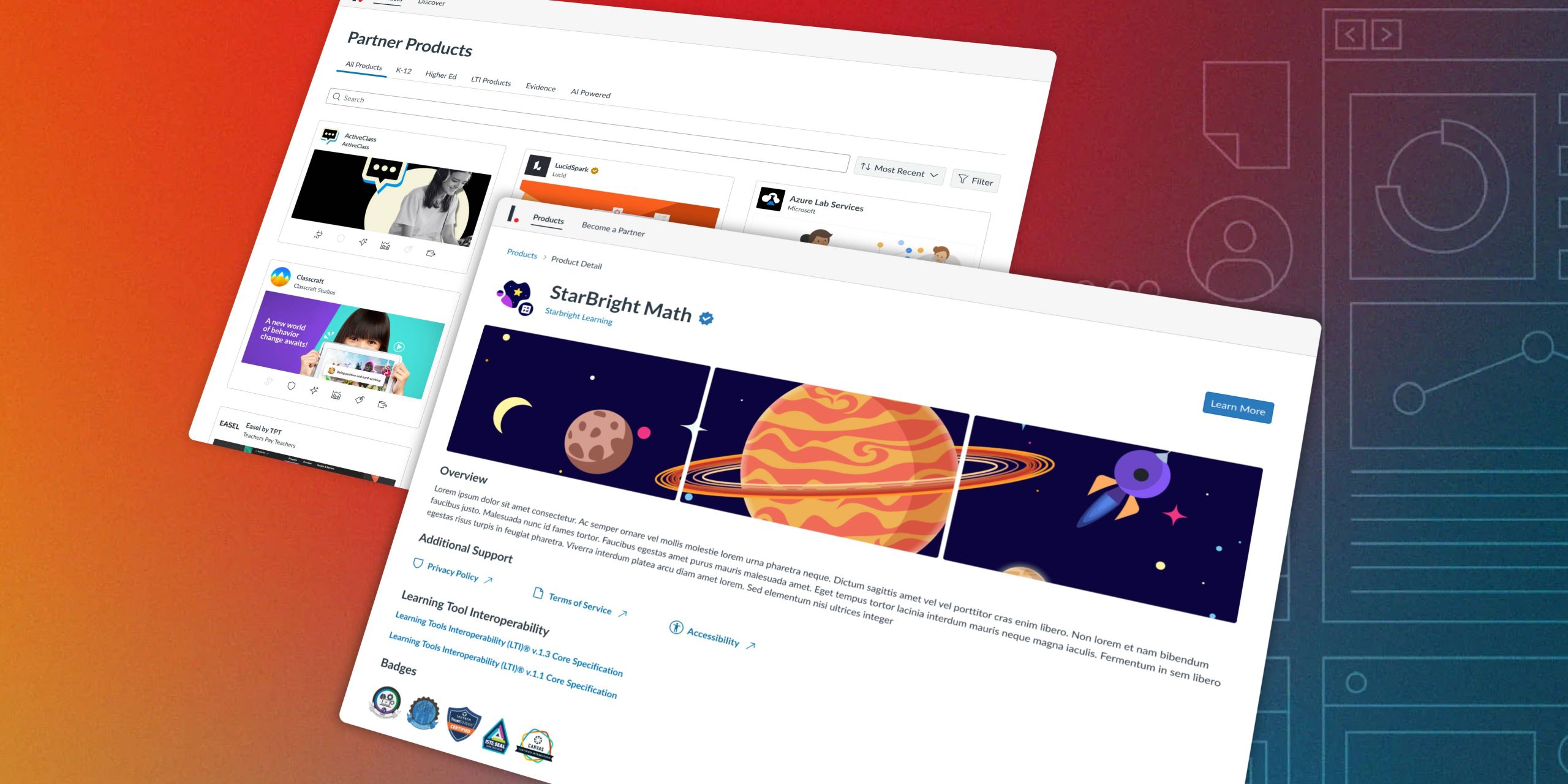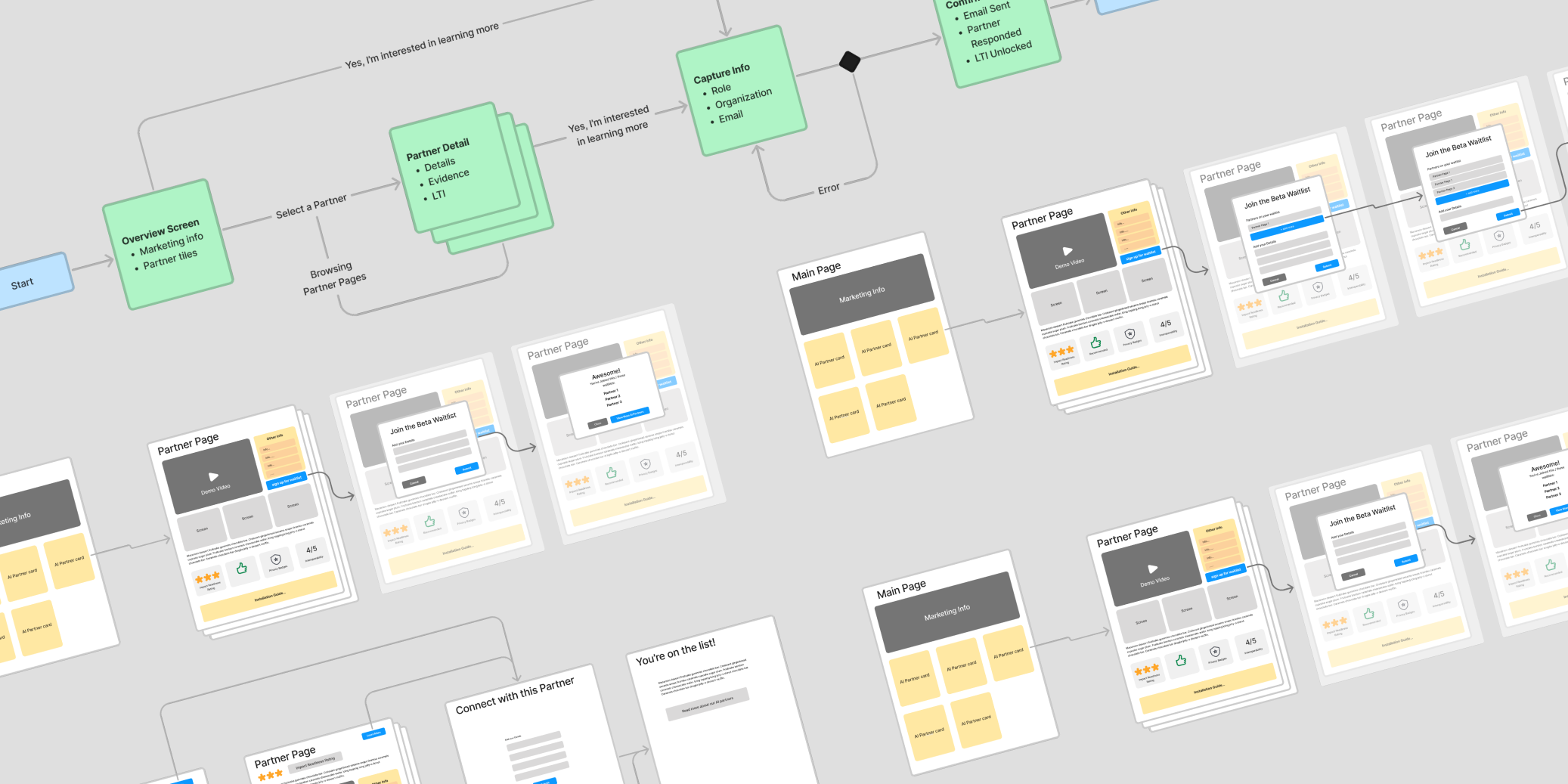
The EdTech Ecosystem
I led the design to improve the EdTech ecosystem, streamlining interactions between EdTech partners, school administrators, and educators increasing opportunities for LTI & Channel Partners
Client
Instructure
Sector
EdTech
Role
Lead Designer
When
Q3-4, 2024
Duration
6 months

Context & Challenges
Context
The 2024 acquisition of LearnPlatform by Instructure created an operational crisis: a fractured EdTech ecosystem. The existing LTI (Learning Tools Interoperability) product libraries were dispersed across three disparate locations: the Emerging AI Marketplace, the Edu App Center, and LearnPlatform’s Learn Community Library. This fragmentation created a significant operational disconnect and eroded the platform’s credibility, as there was no single, authoritative source of truth for Instructure’s vetted LTI tools.
The High-Cost Challenge
The primary challenge was the scale of manual process failure. Managing product data across three existing, manually-maintained frameworks was unmanageable, directly resulting in:
- Stale Data: Partners could not efficiently update their product information, leading to outdated listings.
- Poor Discovery: School Administrators and Educators were unable to easily discover, vet, and procure the right tools, slowing down adoption and reducing partner opportunities.
- Ambiguous Vetting: The lack of a unified system complicated the internal compliance and vetting process for new resources.
The business mandate was clear: consolidate three systems into one unified, scalable marketplace.

Problem & Solution
The Limited Library and the Crisis of Trust
Our three existing, disconnected libraries created friction at every touchpoint. The central problem was a limited library experience that failed three key user groups:
- Admins/Educators: Struggled with tool discovery and lacked clear, factual information for procurement.
- EdTech Partners: Lacked an intuitive, single portal to manage their products and connect with potential purchasers.
The Challenge: Designing for Scale and Ecosystem Health Our core challenge was articulated in this question: “How might we design a single, compelling, and modular EdTech library that provides intuitive discovery for Administrators/Educators and streamlined management for EdTech Partners, thereby strengthening the entire Instructure ecosystem?”
Our Measurable Project Goals:
- Reduce EdTech Partner Support Tickets related to product management by 20%.
- Increase Product Discovery (new tool installations) by 15% in the first six months.
- Establish a definitive Single Source of Truth for all LTI vetting and documentation.
Building the EdCo Marketplace
Our solution was to retire all existing libraries and build a single, unified EdCo Marketplace. This strategy was grounded in three guiding principles:
- Unified Experience: One seamless product library integrated across Instructure’s LearnPlatform, Canvas, and the Partner Portal.
- Future-Proof Foundation: Leveraging the Instructure UI Design System to ensure accessibility (WCAG AA) compliance and create a modular, scalable structure for future AI and personalized recommendation features.
- Focus on Core Task Flow: Prioritizing a mobile-first design approach ensured the complex administrative flows were simplified and highly responsive, accessible on any device

Discovery & Process
Continuous Discovery, Unifying User Needs
Continuous discovery research was instrumental in revealing the critical pain point: both Institution Administrators and EdTech Providers lacked a streamlined way to interact and exchange verifiable information. Administrators struggled to access clear, factual vetting documentation about tools, while providers lacked an intuitive channel to manage product documentation.
User-Centered Methodology
We adopted a focused process to synthesize these contrasting needs:
Interviews → Personas → User Stories → User Flows
- Administrators & Educators Focus: We conducted interviews focused on their current vetting and procurement processes, specifically investigating the criteria needed to trust a new LTI resource.
- EdTech Partners Focus: We investigated how they prefer to manage interactions and documentation, uncovering a high demand for a self-service portal.
The Critical Insight
Trust, not quantity, was the primary blocker. The system needed a transparent mechanism to verify and display vetting compliance status to the Administrators, making the process faster and more trustworthy.
Leveraging AI for Synthesis
To handle the volume of qualitative data, we leveraged AI tools to consolidate interview transcripts and generate refined user personas and user-needs matrices. This allowed the team to quickly develop empathy-driven design hypotheses and significantly minimize errors during the validation phase.

Ideation & Development
Ideation: Translating Needs into Vetting Workflows
With the critical insight (the need for vetting transparency) confirmed, our ideation focused on creating two specific, streamlined workflows: The Partner Self-Service Portal and The Admin Vetting View.
I led the creation of Actionable User Flows, mapping out the end-to-end process from a Partner uploading documentation to an Admin viewing the verified status. This process was a collaborative effort with Product Management to align page functionality with the intended user outcome.
Key Feature Design Decisions:
- The Vetting Status Toggle: We designed a clear status indicator for Admins, allowing them to instantly see the compliance level of any LTI tool without leaving the marketplace. (This directly addresses the ‘trust’ insight).
- Documentation Upload Modal: We created a dedicated, secure partner workflow for uploading vetting documentation, complete with privacy controls and password fields. (This directly addresses the Partner self-service need).
Development & Technical Feasibility:
To stay on a tight 6-month delivery schedule, we focused on rapidly created L3 Mockups (high-fidelity screens without final pixel perfection). These screens were crucial for early collaboration with our engineering team, allowing us to test and validate complex technical requirements (like API calls for vetting status) and ensure our design intentions were technically feasible before committing to development.

Delivery & Impact
Delivery: Establishing a Scalable Foundation
The EdCo Marketplace launched successfully on time. A key focus of the final development phase was not just the product, but the process. We spent several weeks establishing a foundational, scalable, and organized workflow for the marketplace to manage future growth.
Seamless Hand-off: Given the complexity of merging three systems into the Instructure UI Design System, a key priority was bridging the communication gap. We leveraged the Instructure UI Design System heavily and meticulously documented every component and interaction, ensuring a seamless, high-fidelity hand-off to engineering.
Impact:
The new Marketplace has been instrumental in achieving our goals:
- Reduction in Friction: Internal data shows a 15% decrease in support tickets from EdTech partners related to product management in the first quarter post-launch.
- Qualitative Administrator Feedback: Early feedback from the administrative cohort praised the new Vetting Status feature for significantly speeding up their approval process.
Future-Forward Design & Reflection:
We designed the EdCo Marketplace with a clear future state in mind. The modular foundation ensures the platform can easily integrate new features, such as personalized AI recommendations and automated compliance checks.
Key Learning:
The most critical takeaway was the necessity of designing for Ecosystem Health. This project was a success because we prioritized the needs of the Partners (self-service) and the Admins (trust/transparency) equally, understanding that their streamlined interaction is the engine that drives product growth for the entire organization.

AI Nutrition

LearnPlatform